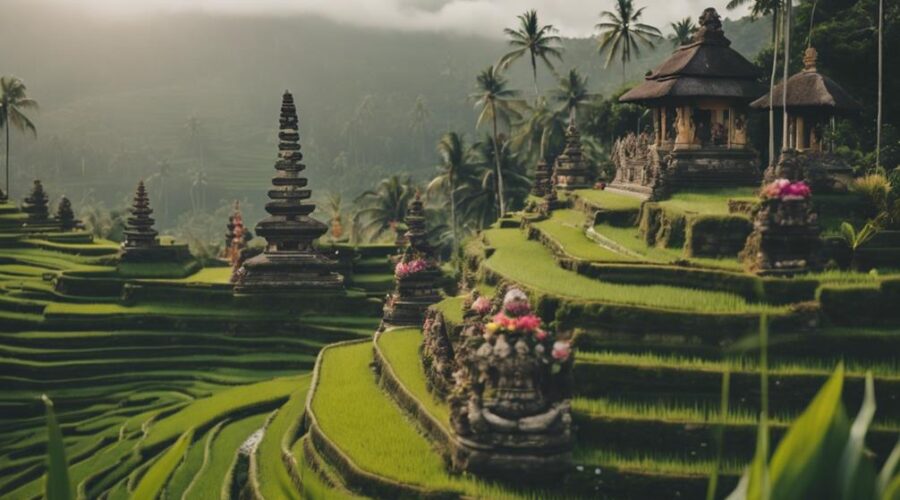Why Is Bali so Religious?
Echoing the tales of Ramayana and Mahabharata, Bali, the Island of the Gods, might seem like a spiritual enigma. You've probably wondered why this tropical paradise is so steeped in ritual and religion.
Well, it's not just the majestic temples or the daily offerings that make Bali religious. It's the amalgamation of Hinduism, Buddhism, animism, and ancestral worship that forms the unique fabric of Balinese spirituality.
Intrigued? Let's explore this further, and you might just uncover the essence of Bali's enchanting allure.
Key Takeaways
- Bali's religiosity is shaped by a unique blend of Hinduism, Animism, and indigenous beliefs, giving rise to a distinct religious identity.
- Daily rituals, ancestral worship, and religious architecture like Meru play a significant role in embedding spirituality in Balinese life.
- The island's religious festivals and celebrations, integral to preserving spiritual beliefs, serve as living embodiments of Balinese faith and culture.
- Despite challenges like cultural commodification due to tourism, Bali maintains its spirituality, largely attributed to the integration of spiritual education and respectful tourism practices.
Bali's Diverse Religious Landscape
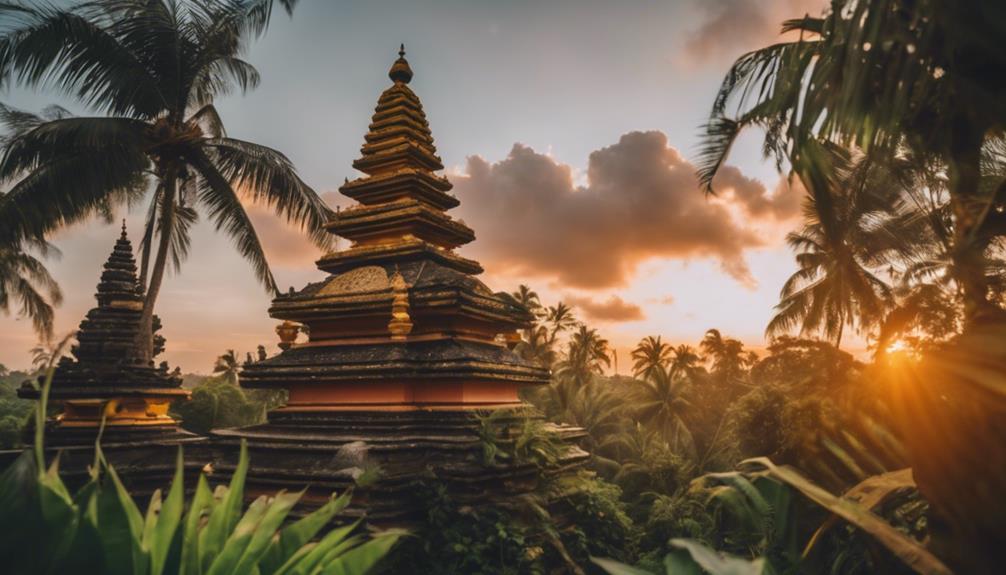
Bali's religious landscape is remarkably diverse, with a multitude of faiths and practices coexisting harmoniously on the small Indonesian island. Religious tolerance isn't just a concept here, but it's the lifeblood that fuels the island's social and cultural dynamics. You'll find a myriad of religious beliefs, from Islam, Christianity, Buddhism, to indigenous animistic practices, all thriving side by side.
Interfaith interactions aren't just tolerated, but actively encouraged, fostering a sense of unity and mutual respect among the residents. This unique blend of diverse faiths has resulted in a rich tapestry of cultural expressions that's unparalleled elsewhere. The island's religious tolerance and interfaith interactions have essentially crafted a blueprint for religious coexistence, where peace isn't a utopian ideal but a lived reality.
The innovative aspect of Bali's religious landscape is its ability to amalgamate, adapt, and evolve without losing the essence of individual practices. It's this dynamic flexibility that has allowed Bali to maintain a harmonious religious environment, despite the diversity. The island's religious landscape serves as an enlightening beacon for those seeking innovative ways to foster religious tolerance and interfaith interaction in their own communities.
The Influence of Hinduism
Despite the diversity, Hinduism, in particular, has had a profound impact on Bali's cultural and religious landscape. It's not just a religion, but a lifestyle, which is profoundly entrenched in Balinese society. The principles of Hindu philosophy are vividly portrayed in their daily rituals, ceremonies, and artistic expressions.
You'll notice the unique blend of Hindu philosophy with indigenous beliefs, a clear demonstration of religious syncretism. This amalgamation of beliefs has resulted in a unique form of Hinduism, distinctively Balinese in character. Balinese Hinduism isn't a mere adoption of Indian traditions; it's a novel interpretation, blending local customs with Hindu elements.
The influence is so pervasive that it shapes the Balinese perception of the world. For instance, the concept of 'Tri Hita Karana', borrowed from Hindu philosophy, is a guiding principle in Bali. It advocates for harmony among humans, nature, and gods – a foundational cornerstone of Balinese life.
Role of Animism in Balinese Religion
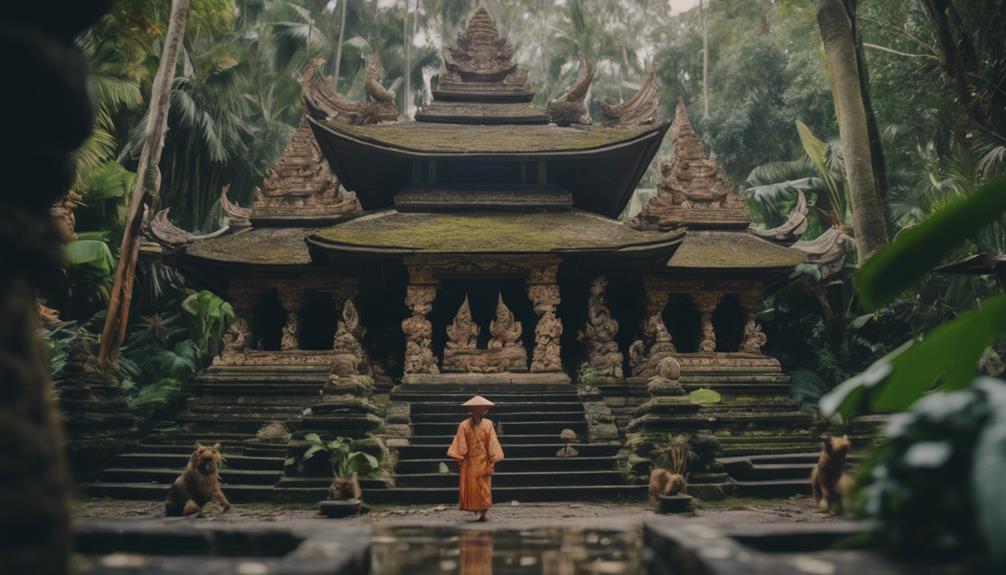
Delving into the spiritual fabric of Bali, you'll find that animism plays a pivotal role, shaping not just religious rituals, but also the island's cultural and environmental worldview. This ancient belief system, predating organized religions, posits that all objects, places, and creatures possess a distinct spiritual essence.
Animistic symbols are pervasive in Balinese culture, embodying the living energy in every aspect of life. Carved statues, intricate offerings, and vibrant ceremonies reflect the Balinese's deep-rooted belief in the omnipresence of the divine in the tangible world. All these cultural manifestations represent a language, a means of communication with the unseen forces that govern their world.
Ancestor worship, another key facet, strengthens the animistic ethos in Balinese religion. Revering ancestors isn't merely an act of homage, but a binding element in the cosmic balance of life and death. Ancestors are considered living entities, their spirits partaking in daily life, guiding and protecting their descendants. This reverence for ancestors cultivates a profound sense of continuity, linking the past, the present, and the future in a cyclical, eternal rhythm.
Bali's Unique Brand of Hinduism
In an intriguing blend of animism and Hinduism, you'll find that the spiritual landscape of Bali is uniquely shaped by a form of Hinduism that's distinctively different from its Indian counterpart. This Balinese Hinduism represents a synthesis of indigenous animist customs and the influence of Indian traders who introduced Hinduism around the first century AD.
Balinese Hinduism, while maintaining the complex Hindu iconography and a caste system, is innovative in its interpretation and application of these elements. The iconography isn't merely decorative, but embodies the Balinese concept of harmony between humans, nature, and divine beings. Gods and spirits aren't distant figures but part of the daily life, depicted in intricate carvings and statues that enrich Balinese culture.
The caste system, traditionally rigid in mainland Hinduism, is more fluid in Bali. There's a focus on spiritual development rather than strict adherence to caste-based roles, reflecting a more egalitarian society. This distinct interpretation of Hinduism contributes to the rich tapestry of Balinese spirituality, creating a unique religious identity that has fascinated scholars and innovators alike. This fusion of belief systems enables Bali to stand out in the religious world.
Daily Religious Routines and Rituals
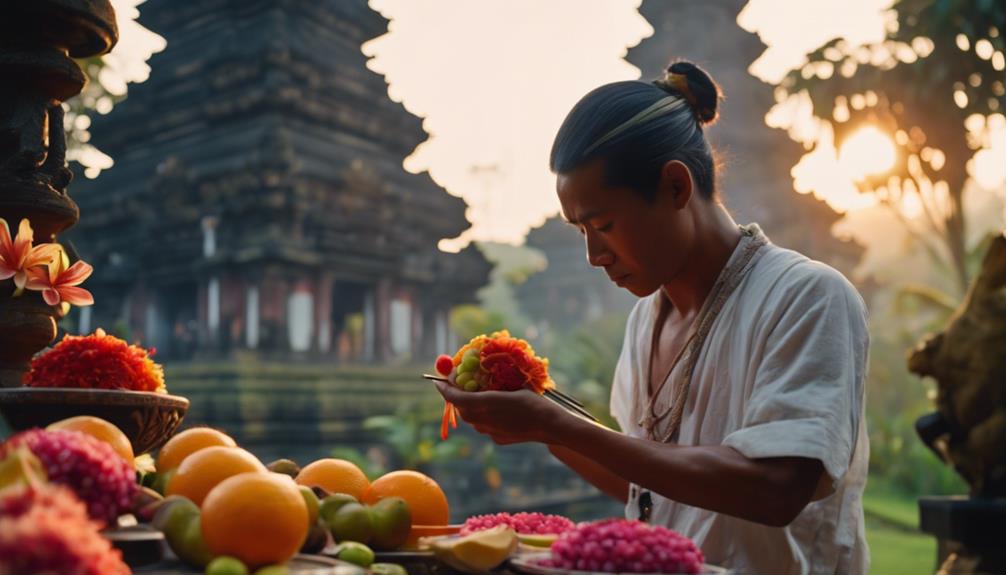
Embracing the rhythm of daily religious routines and rituals offers a deeper understanding of how Balinese Hinduism permeates the lives of the island's inhabitants. The islanders' devotion isn't just confined to temples; it's woven into the fabric of everyday life, creating a vibrant tapestry of faith and tradition.
- Morning Prayers: As dawn breaks, the island hums with the recitation of mantras, an integral part of Balinese Hinduism
- Ancestor Worship: Ancestor altars in homes serve as constant reminders of the spiritual connection between the living and the departed.
- Religious Tattoos: The intricate, symbolic tattoos carry spiritual significance, often reflecting a person's devotion or religious journey.
- Offering Baskets: Hand-woven from palm leaves and filled with flowers, food, and incense, these offerings are a daily ritual of giving thanks.
- Festivals: The Balinese calendar is replete with religious festivals, each with its unique rituals and ceremonies.
The Balinese demonstrate that faith isn't a once-a-week practice, but a lifestyle. These daily routines and rituals, including religious tattoos and ancestor worship, underscore a deep-rooted belief system that permeates all aspects of life, creating a harmonious blend of spirituality and daily existence.
Sacred Temples and Shrines of Bali
As you traverse the island of Bali, you'll encounter a multitude of sacred temples and shrines, each bearing proof to the deeply ingrained spirituality of the Balinese people. These structures, steeped in sacred symbolism, are embodiments of a complex and nuanced religious culture that permeates every aspect of Balinese life.
Consider the temple architecture. It's not random or purely aesthetic; each element conveys deep, symbolic meanings. The orientation, layout, and decor of Balinese temples reflect cosmological principles, societal hierarchies, and spiritual aspirations. The intricate designs and patterns aren't just visually arresting; they're representations of important religious and philosophical concepts.
To help you appreciate the depth of this sacred symbolism, here's a brief overview:
| Temple Element | Symbolic Meaning |
|---|---|
| Mount Meru Sculpture | Cosmic center, abode of the gods |
| Candi Bentar (split gate) | Change from mundane to sacred |
| Kulkul (wooden bell) | Call to prayer and community |
| Padmasana (lotus throne) | Seat of the divine |
| Pelinggih Meru (multi-tiered shrines) | Mountains, domains of the gods |
As you explore these temples, you'll realize that they're not just architectural marvels or tourist attractions. They're living, breathing expressions of Bali's vibrant religious culture.
Importance of Religious Festivals
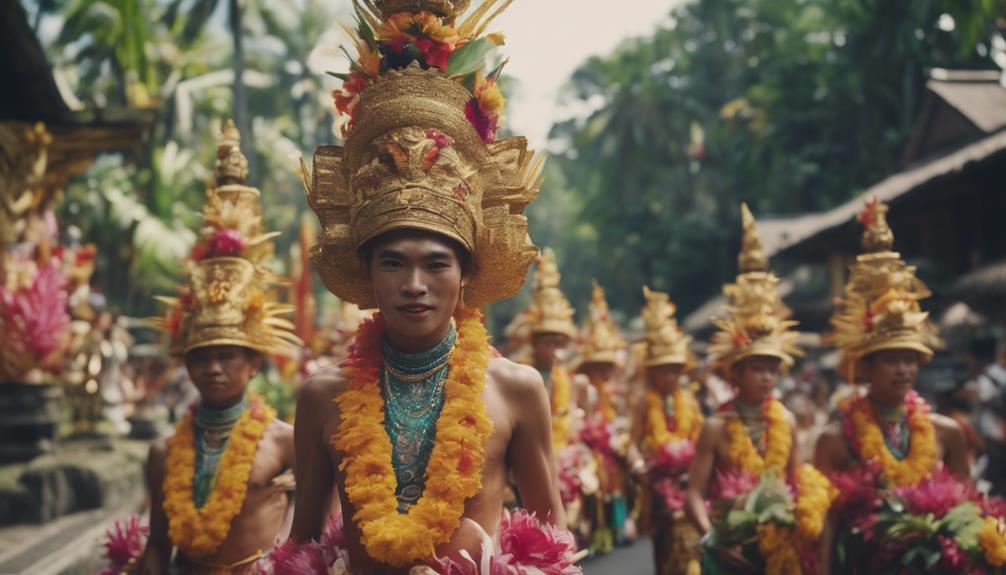
As you explore the importance of religious festivals in Bali, you'll find the significance of festive rituals deeply rooted in Balinese culture.
Traditional celebrations aren't merely events, but integral components that shape and influence the local culture.
They serve as a vibrant testimony to the island's rich religious history and undying devotion.
Significance of Festive Rituals
In Bali, the plethora of religious festivals holds a significant role, serving as a conduit for the Balinese to express their devotion and maintain a harmonious relationship with the divine. Festive attire and ritual symbolism are integral, providing a visual representation of the island's deep spiritual bond.
To create imagery in your mind, consider the following:
- The vibrant hues of the traditional attire, mirroring the island's rich cultural tapestry.
- Intricate patterns symbolizing spiritual concepts and deities.
- The scent of incense wafting through the air, creating an atmosphere of reverence.
- The rhythmic chants and hypnotic gamelan music, echoing the island's devotion.
- The meticulously crafted offerings, a sign of the Balinese's dedication to their faith.
Every element is carefully chosen, symbolizing a facet of Bali's religious life, enhancing the general belief system.
Traditional Balinese Celebrations
You'll find that Bali's religious festivals, an integral part of the island's cultural fabric, play a pivotal role in the preservation and expression of its deep-rooted spiritual beliefs.
These celebrations, splashed with vibrant celebration attire, mirror the island's rich tapestry of faith and tradition. Intricate ceremonial wear, from sarongs to udeng headdresses, provides a visual feast, symbolizing the profound sanctity of these occasions.
Simultaneously, culinary traditions play an equally significant role. Traditional dishes, meticulously prepared, not only serve as communal sustenance but also as offerings to the divine. These practices encapsulate the fusion of ceremony and daily life, reinforcing Balinese spirituality.
The island's religious festivals aren't mere observances, but living, breathing embodiments of its faith.
Impact on Local Culture
These religious festivals don't just embody Balinese faith, they also profoundly shape the local culture, underscoring the entwined nature of spirituality and everyday life on the island. They're not merely ceremonial, they're a catalyst for social integration, community development, and cultural preservation.
Consider the following:
- The elaborate temple decorations, a proof of the community's collaborative spirit and artistic flair.
- The rhythmic gamelan music, echoing a harmonious coexistence of man, nature, and spirituality.
- The traditional dances, dramatizing myths and legends, are a vibrant medium of cultural transmission.
- The strategic planning and execution of these festivals foster leadership and organizational skills.
- The influx of Religious Tourism during these festivals, boosting local economy and promoting Spiritual Retreats.
Spirituality in Balinese Art and Dance
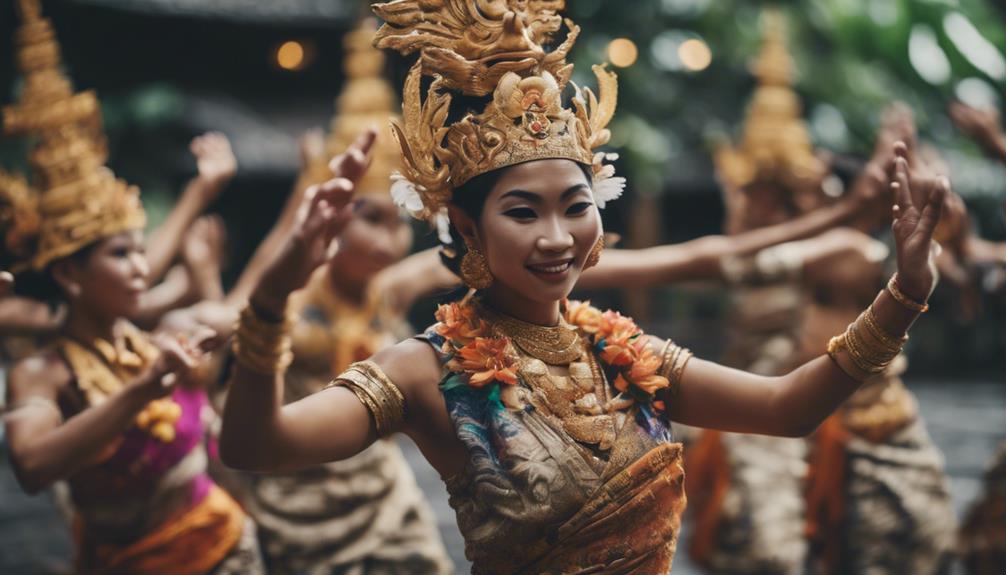
As you explore Balinese culture, you'll find that spirituality considerably shapes the island's art forms.
In particular, dance is utilized as a medium for divine expression, embodying the intricate relationship between culture, art, and religion.
This powerful intersection offers a profound understanding of the spiritual depth that permeates every aspect of Balinese society.
Influence of Spirituality on Art
Bali's art and dance forms, deeply steeped in spirituality, serve as vibrant expressions of the island's unique religious beliefs. This artistic spirituality isn't just for show; it's a core part of Balinese culture and a key driver of spiritual tourism. Religious symbols permeate every aspect of their art, infusing it with a deeper meaning that resonates with both locals and visitors.
To truly appreciate Balinese art, consider these elements:
- Intricate wood carvings depicting various deities
- Colorful paintings filled with symbolic imagery
- Skillfully crafted silver jewelry with religious motifs
- Hand-woven textiles featuring complex patterns
- Traditional masks used in spiritual ceremonies
These art forms don't just beautify; they communicate, teach, and inspire, encapsulating the profound influence of spirituality on Balinese art.
Dance as Divine Expression
In exploring the deep-rooted spirituality in Balinese art, one can't overlook the dynamic role of dance as a divine expression of religious beliefs and cultural values. Dance symbolism is used to convey deep spiritual and cultural narratives, with each move imbued with profound meaning. Choreographic interpretations become a means of expressing the divine, highlighting the dance as more than mere aesthetics—it's a form of prayer, an act of devotion.
Each dance step, every rhythmic beat, is a direct communion with the divine. The sacredness of these dances emphasizes the deeply ingrained connection of the Balinese people with their spirituality, making Bali a unique hotspot of religious expression through art. The dance isn't just an art form—it's a spiritual discipline.
Cultural Art and Religion
Moving from the dance floor to the canvas, you'll find that Balinese art, much like its dance, serves as a mesmerizing affirmation of the island's profound spirituality. This is evident in:
- The intricate designs of religious tattoos, acting as personal spiritual symbols.
- The vibrant and symbolic colors used in traditional paintings.
- The spiritual cuisine offered at temples, reflecting a fusion of the sacred and the delicious.
- The detailed wood carvings illustrating ancient religious stories.
- The stunning architecture of temples that captures the spiritual essence of Bali.
These elements, alongside Bali's mesmerizing dances, highlight the island's deep-rooted spirituality.
You'll see that Balinese culture isn't just about aesthetics—it's an innovative expression of faith, making Bali so distinctively religious.
The Concept of Karma in Bali
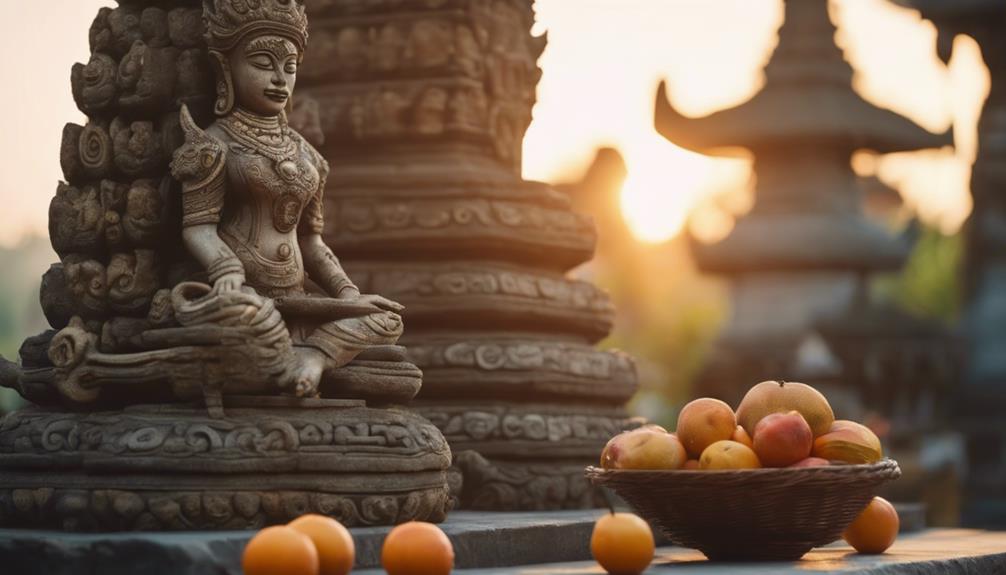
You'll find that the concept of karma plays a pivotal role in the religious life of Balinese people. In Bali, karma isn't just a vague, spiritual concept, but a tangible force that guides daily actions and decisions. Karma interpretations here are dynamic and complex, intertwined with the intricate tapestry of Balinese culture.
In Balinese Hinduism, karma is seen not simply as a cause-effect relationship but as a cycle of spiritual consequences that can span multiple lifetimes. It's believed that the deeds one performs in this life influence their fate in the next. This understanding of karma fosters a deep sense of responsibility and moral discipline, encouraging individuals to live in harmony with others and the environment.
The Balinese also believe in the concept of 'karmaphala', the fruit of karma. This principle motivates them to act mindfully, knowing that their actions today will bear fruit in the future. This innovative approach that emphasizes accountability and mindfulness shapes the religious ethos of Bali.
The Balinese interpretation of karma is a tribute to their rich spiritual tradition, a creative approach that breathes life into ancient wisdom. It's a fascinating lens to understand why Bali is so religious.
Bali's Religious Education System
Building on the profound influence of karma in Balinese life, it's important to understand how the island's religious education system works to instill these values from an early age. Spiritual Education in Bali isn't just a marginal part of the curriculum; it's woven into the very fabric of schooling.
The Balinese educational system includes:
- Daily religious rituals performed in schools.
- Inclusion of spiritual teachings in the curriculum.
- School trips to temples as part of Religious Tourism.
- The teaching of karma principles in every subject.
- Balinese arts as a medium to convey religious messages.
This system encourages a deep-rooted understanding of the island's spiritual values, giving students a profound appreciation for religious customs. It's not just about rote learning; it's about living the teachings every day, resulting in a populace deeply committed to its faith.
In a world that's leaning towards digitization, Bali's approach to Spiritual Education is a breath of fresh air. It's an innovative blend of tradition and education, a unique model that breeds harmony and respect for one's cultural heritage. It's no wonder Bali remains a bastion of spirituality amidst the rapid modernization of the world.
Impact of Tourism on Balinese Religion
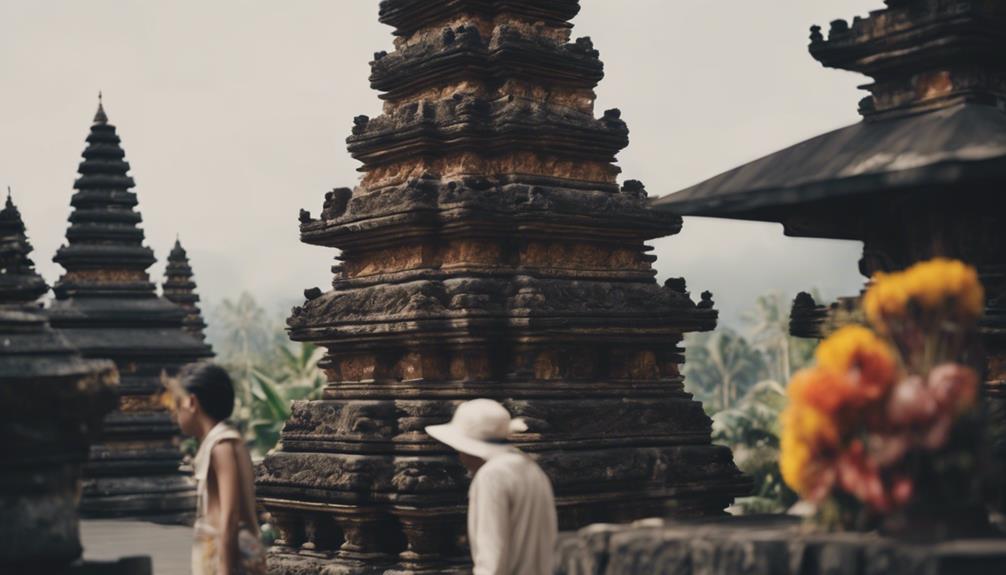
Despite its inherent spirituality, Bali's religious landscape has not been immune to the effects of tourism, a phenomenon that has brought about a complex interplay of cultural preservation and economic development. This has led to a trend of tourism commodification, where sacred rituals and structures are often marketed as exotic attractions.
| Aspect | Impact |
|---|---|
| Cultural Integrity | Tourism commodification can dilute the spiritual significance of religious practices, leading to a form of spiritual commercialization. |
| Economic Development | Despite the risks, tourism provides a major source of income, supporting the upkeep of temples and ceremonies. |
| Cultural Exchange | Tourists often gain a deep appreciation for Balinese religion, promoting global understanding and respect.
While this interaction has its downsides, it's important to acknowledge the potential for innovation. By fostering respectful and inclusive tourism practices, there's an opportunity to strike a balance between preserving tradition and embracing economic growth. In doing so, you can help assure that Bali's religious practices continue to thrive, nurtured by both local devotion and global admiration. The future of Balinese religion might well depend on how successfully this balance is struck.

